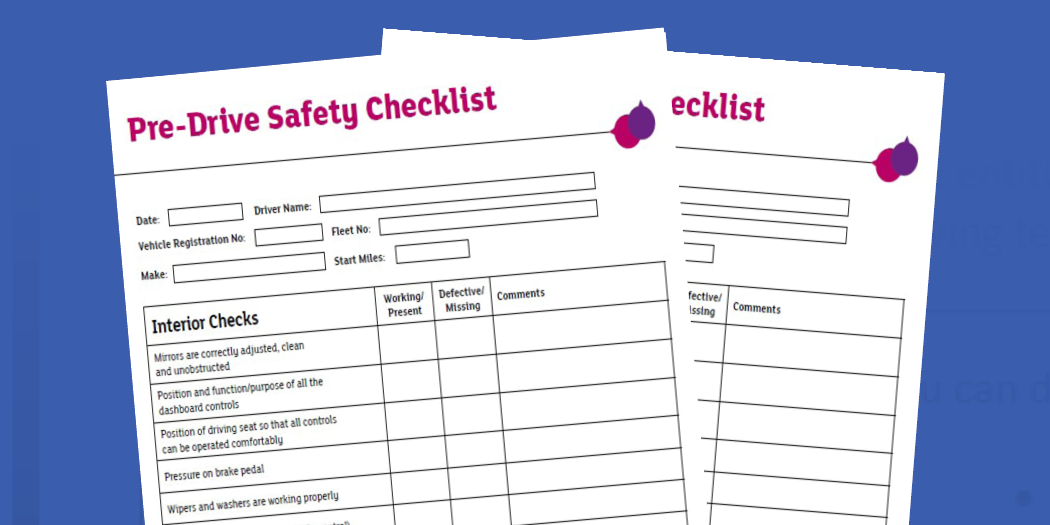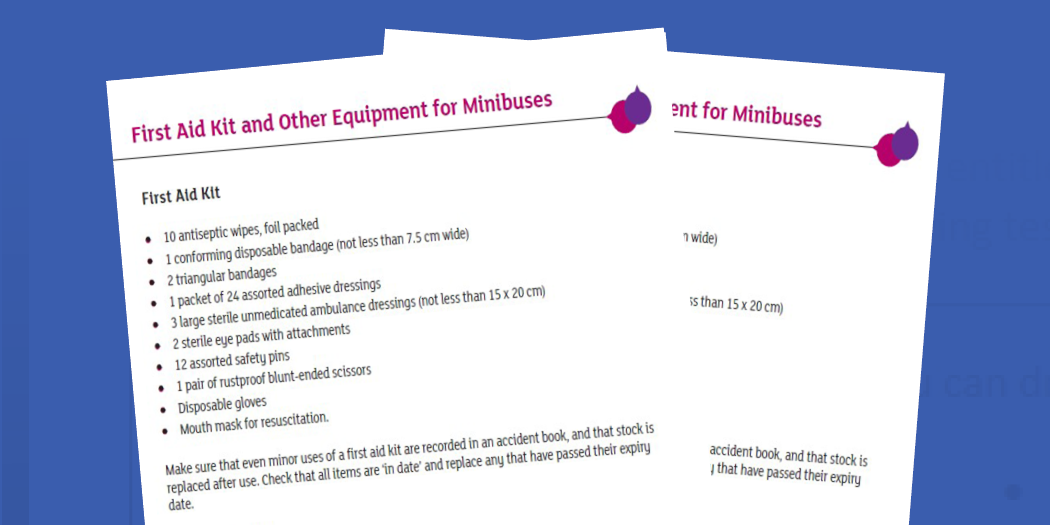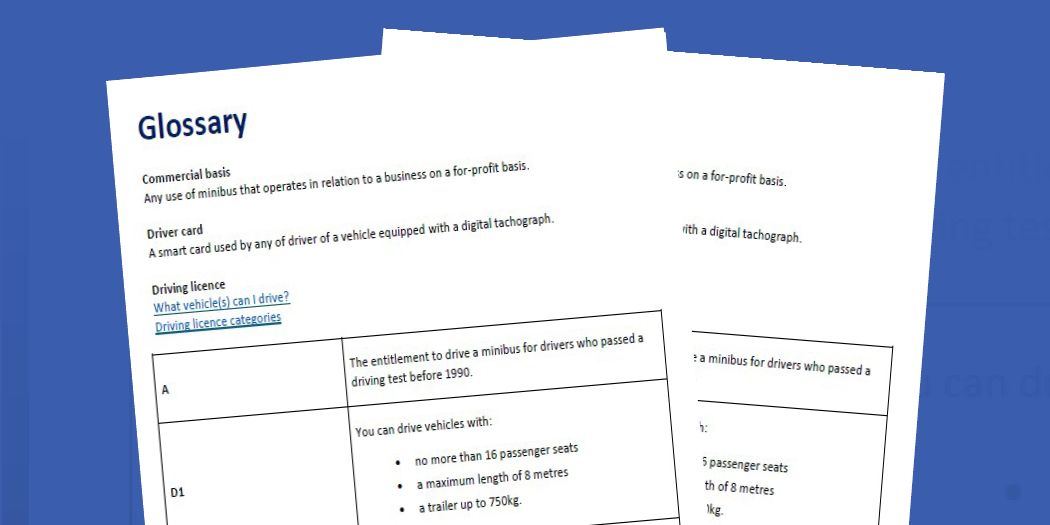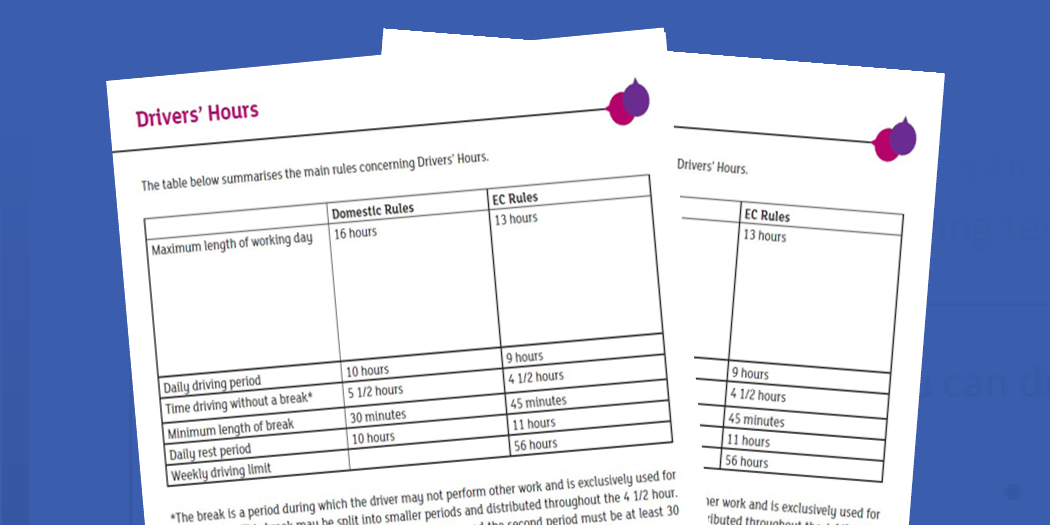
Operators
What is a minibus?
A minibus is a vehicle designed to carry up to 16 passengers (not including the driver) with a gross vehicle weight (GVW) not exceeding 3.5 tonnes (4.25 tonnes if specialist equipment is fitted).
Gross vehicle weight - the total weight of the vehicle, the passengers, the driver, fuel, equipment and/ or luggage and any fixtures or additional fixtures or specialist equipment. It is the driver’s responsibility to ensure that the GVW is not exceeded. (You may see GVW expressed as MAM – Maximum Authorised Mass).
Who can drive a minibus and on what basis?
Minibuses may be operated by commercial organisations operating a bus service, shuttle service, bus and driver hire, or as a tour operator. They may also be operated by independent schools (non-charitable status), sports clubs and religious institutions that require a payment (and make a profit) from passengers.

Minibus Safety: Pre Drive Safety Checklist

First Aid Kit and Other Equipment for Minibuses

Glossary

Drivers hours
In order to drive a minibus you must:
-
Be at least 21-years-old
-
Be insured to drive the minibus
-
Have the owner’s permission to drive it
-
Ensure the minibus is roadworthy, taxed and has a current MOT
-
Ensure the minibus displays a minibus permit (if it is being used under a permit scheme).
Best Practice
Ensure that all drivers have the appropriate entitlement on their driving licence.
-
It is the operator’s and individual driver’s responsibility to ensure that the driver is appropriately licensed to drive the minibus. If challenged, an individual driver and the operator would have to show that the driver had a valid licence to drive the minibus.
-
An interactive flowchart that allows people to check what vehicles their driving licence entitles them to drive is available on the Government website.
|
A
|
The entitlement to drive a minibus for drivers who passed a driving test before 1990.
|
|
D1
|
You can drive vehicles with:
|
|
D1E
|
You can drive D1 category vehicles with a trailer over 750kg MAM (Maximum Authorised Mass).
The combined MAM of both cannot exceed 12,000kg.
|
|
D
|
You can drive any bus with more than 8 passenger seats (with a trailer up to 750kg MAM).
|
|
DE
|
You can drive D category vehicles with a trailer over 750kg.
|
For hire and reward
|
Entitlement for a driver who passed their driving test before 1 January 1997
|
Entitlement for a driver who passed their driving test after 1 January 1997
|
|
These drivers automatically received D1 or A entitlement and may drive a minibus provided that:
-
The driver is 21 or older
-
The minibus has no more than 16 seats and the gross weight does not exceed 7.5 tonnes.
-
If the driving licence has 101 stated next to category D1, it means that the minibus cannot be driven for hire or reward.
|
These drivers do not automatically receive D1 Entitlement and may only drive vehicles in the B category (up to 8 passengers)
To drive a minibus the driver must apply for a D1 entitlement.
|
What vehicle excise duty (road tax) does a minibus need?
The taxation class of a vehicle depends on whether it carries passengers or goods, its weight, its construction and the purpose for which it is used. Operators are advised to check with the Driver and Vehicle Licensing Agency (DVLA) whether their minibus should be registered and taxed as a private/light goods vehicle or as a bus.
What insurance does a minibus need?
You must have motor insurance to drive your vehicle on UK roads. The operator must ensure that the vehicle, and its driver(s), are insured for all of the purposes to which the vehicle will be put, including whether it is used for ‘hire and reward’ and/or under a Section 19 Permit (Section 10B in Northern Ireland) and whether it is registered as a Passenger Service Vehicle or a Private/Light Goods Vehicle.
Third party insurance is the legal minimum. This means you’re covered if you have an accident causing damage or injury to any other person, vehicle, animal or property. It does not cover any other costs like repair to your own vehicle.
Check that the insurance policy covers:
-
All the services for which the minibus is used
-
The number of passengers allowed and the total weight (including passengers and luggage)
-
All the people authorised to drive the minibus
How do I ensure that an employee is suitable to drive a minibus?
Operators should ensure that every minibus driver:
-
Has the appropriate driving licence entitlement to drive the minibus
-
Undergoes initial and periodic assessments of ability to drive a minibus, especially if they do not drive a minibus regularly or are driving one after a long period of not doing so
-
Undergoes a re-assessment if involved in a blameworthy collision, receives a fixed penalty or is prosecuted for a motoring offence or a concern about their driving is raised
-
Receives practical driver training in a minibus, as necessary, under the conditions in which they are likely to drive the minibus
-
Understands his or her responsibilities
-
Is medically fit to drive
-
Ensures they are well rested before driving and takes rest breaks (about every two hours) on long journeys
-
Is accompanied by a second driver, who is also fully qualified and meets the same conditions as the first driver, where necessary
-
Is accompanied by a passenger assistant where passengers needs require it
What training do minibus drivers require?
Ensure that all drivers receive induction training and are regularly re-assessed, and re-trained as necessary, to maintain their driving skills and standards.
Minibus driver training will normally include:
-
Passenger care, including disability awareness (if applicable)
-
Using passenger lifts or ramps (if relevant)
-
Passengers travelling in wheelchairs
-
Proper use of seatbelts, harnesses and other passenger safety equipment
-
On road assessment on the types of road the driver is likely to use (e.g., motorways or dual carriageways, urban and/or rural roads)
Re-assessment of drivers should be a fundamental part of the management system. It should take place at least once every four years, and more often if an incident merits it.
You can also consider asking drivers to complete Minibus Driver Awareness Scheme (MiDAS) training.
What are the fitness to drive requirements for minibus drivers?
Operators should establish a process to assess the medical fitness to drive of their drivers on a regular basis.
A simple eyesight test for drivers on appointment and at re-assessment should also be conducted. The DVLA has more information on driving eyesight requirements.
-
Drivers should report to the operator any change in their health that affects their ability to drive.
-
Drivers should never drink and drive and be aware that alcohol can remain in the body for up to 24 hours.
-
Drivers should never drive after taking illegal drugs, or if under the influence of drugs.
-
Drivers must not drive if ill, or affected by medicines.
Further advice is available in RoSPA’s Guide ‘Driving for Work: Drink and Drugs’ and at Drugs and Driving: the law.
What permits does a minibus need?
Minibus and community bus permits
Organisations that provide transport on a ‘not-for-profit’ basis can apply for permits under Section 19 or Section 22 of the Transport Act 1985. These permits allow the holder to operate transport services for hire or reward without the need for a full public service vehicle operator’s (PSV ‘O’) licence.
Permits issued under section 19 - relating to the use of vehicles by educational and other bodies
-
These permits allow certain non-profit-making organisations (including schools) concerned with education, religion, social welfare, recreation or other activities of benefit to the community, to make a charge for being carried on a minibus without having to comply with the full PSV licensing requirements and, in some circumstances, without their drivers needing to have a PCV (category D1 or D) licence.
-
The following conditions must be met whenever a permit minibus is used; the:
-
minibus must only be used by the organisation to whom the permit has been granted, or by affiliated/associate members of that organisation; and
-
minibus must not be used by members of the general public and
-
minibus must not be operated for profit, or for an activity which in itself is carried out for profit; and
-
minibus must meet the requirements for initial fitness as defined by the Construction and Use Regulations; and
-
permit disc must be displayed on the nearside of the windscreen, visible from the outside of the vehicle.
Permits issued under section 22 - community bus permits
-
Community Bus Permits are issued under Section 22 of the Transport Act 1985, as amended, to bodies that run a local bus service on a voluntary non-profit basis. The rules are similar to those for Section 19 permits. However, members of the general public can be carried in the minibus.
For further advice see:
Section 19 and 22 permits and obligations: not for profit passenger transport
Apply for a section 19 permit
Minibus permit (if you need to charge running costs)
You can apply for a minibus permit if you need to charge passengers, as long as:
-
the vehicle can carry between nine and sixteen passengers
-
you’re driving it for a voluntary organisation that benefits the community - for example, an educational, religious or sports organisation
-
the minibus service is only available for members of that organisation - not to the general public
-
any charges are to cover running costs and are not for profit
You can apply for a minibus permit from the Driver and Vehicle Standards Agency (DVSA).
What permits do I need to drive a minibus commercially?
You need a public service vehicle (PSV) operator’s licence to:
There are four types of PSV operator licences, plus special licensing rules for London:
-
Standard licence – for national operations only; you can only operate in Great Britain
-
Standard licence – national and international operations; allows you to take passengers abroad as well as within Great Britain
-
Restricted licence – for small-scale operations; for use with one or two vehicles
-
Special restricted licence – for licensed taxi operators that provide a local service
More information can be found here.
Does the minibus need a school sign to carry children?
School bus signs
Under the Road Vehicles Lighting (Amendment) Regulations 1994, minibuses carrying children to or from school must display a prescribed ‘school bus’ sign to the front and rear of the vehicle. The driver may use hazard warning lights when the vehicle is stationary and children are entering or leaving the vehicle.
What are the seatbelt laws for drivers and passengers?
-
Passengers should only be carried in a minibus that is suitable for their needs.
-
Seatbelts must be provided on all seats and all passengers must wear their seat belt.
-
Operators must display seatbelt signs in the minibus.
-
Seatbelts and their fitment must comply with legal standards.
Futher Government advice on seatbelts in minibuses.
Appropriate child restraints
Minibus operators do not have to provide child restraints on minibuses, but if they are “available”, they must be used by children aged up to 12 years old or 135cm in height, whichever comes first.
Passenger restraints
Some disabled passengers may need postural support during the journey, and a variety of passenger restraints to assist people with disabilities to remain upright in their seat are available. Under no circumstances should they be used instead of a suitable seatbelt as they do not conform to a recognised standard nor are they designed for this purpose.
What safety equipment needs to be kept in the minibus?
Regulation 42 and Schedule 7 of the Road Vehicles (Construction and Use) Regulations 1986 specify that every minibus must carry a British Standard fire extinguisher of water or foam, with a minimum test rating of 8A or 21B. If passengers in wheelchairs are being carried, the minibus should carry two fire extinguishers, one of which is kept in the passenger compartment.
Fire extinguishers should be tested according to the manufacturer’s instructions, which is usually once a year. Drivers and passenger assistants should be trained in their use.
The regulations also specify that a suitable, clearly marked first aid box is kept readily available and in good condition.
What records do I need to keep?
The law requires operators to keep records of how they ensure the service they provide is safe. RoSPA recommends that records are kept for at least 15 months.
It is recommended that the following records are kept:
-
Operating log, including booking the vehicle in and out
-
Accident/Incident book, including faults reported and rectified
-
List of authorised drivers
-
Training and re-training forms
-
Medical check details
-
Emergency equipment form
-
Details of any vetting conducted
-
Contact names and details (including out-of hours details). The individuals concerned should consent to their personal details being recorded for this purpose and the data should be stored in accordance with data protection law.
-
Maintenance/safety checks.
Do minibuses need to have speed limiters fitted?
Minibuses must be fitted with speed limiters as required by law.
-
Minibuses first used or registered on or after 1 October 2005 must have a speed limiter fitted. Minibuses used abroad must be fitted with a speed limiter.
-
The limiter restricts the maximum powered speed of the minibus to 62mph (100 kph). Minibuses fitted with a limiter cannot use the outside lane of a motorway that has three or more lanes.
What do operators need to have in place in case of emergencies?
Clear emergency procedures should be in place and should be included in driver and escort training.
Breakdown Procedures
-
Operators must ensure that there is a clearly defined written procedure which must be followed in the event of a breakdown and that all drivers and escorts are aware of, and adhere to it. Regular vehicle checks and maintenance will reduce the likelihood of the minibus breaking down during a journey. But even a well maintained minibus can break down, and operators may wish to arrange a service contract with a garage or rescue organisation.
Crashes and emergencies
-
Operators must ensure that there is a clearly defined written procedure which must be followed in the event of a collision or other emergency (such as passenger illness) and that all drivers and passenger assistants are aware of, and adhere to it. A copy of the procedure should be kept inside the vehicle.